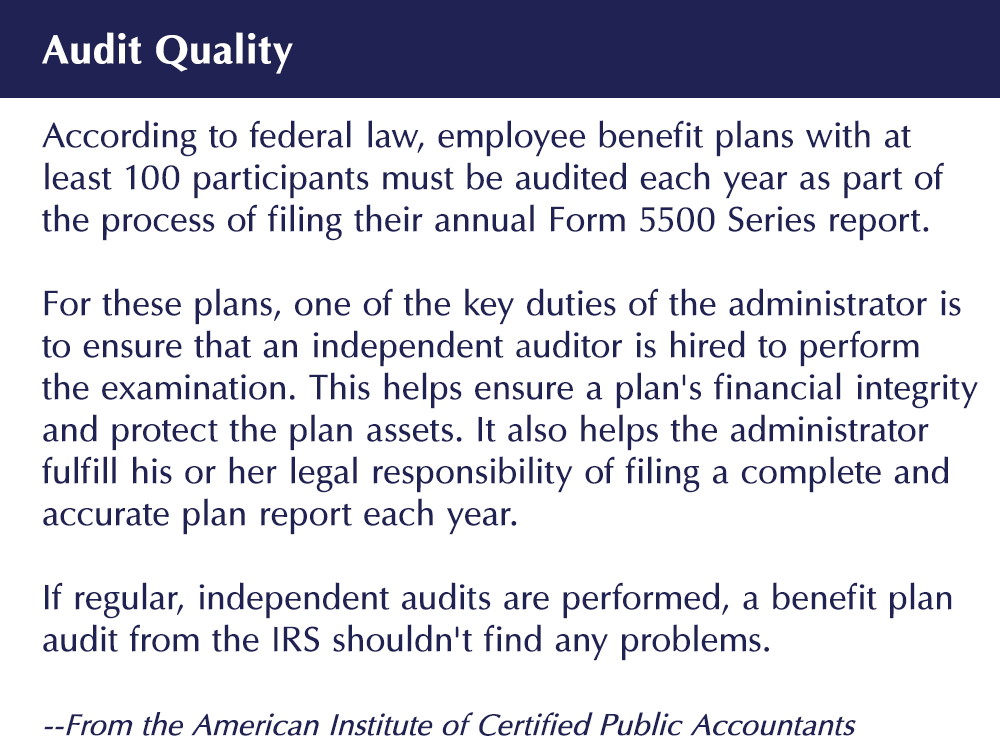Receiving a notice that the IRS is auditing an employee benefit plan is news that no employer wants to receive. If your company does get such a notice, knowing what to expect and preparing for the audit itself are the best ways to help the process go as smoothly as possible. In one IRS newsletter, the agency’s Director of Employer Plan Examinations advised plan sponsors of the audit process and gave readers a list of tips on how to best handle the situation.
An audit will generally be held at the employer’s principal place of business. The audit notice lists the items that the IRS agent wants to examine. We have a team of employee benefit plan experts who can help you review the list prior to the audit.
The IRS offers these “Top Ten Tips to Prepare for an Efficient Audit”
1. Have readily available plan documents (including amendments), summary plan descriptions, etc. (include all prior versions requested); opinion letters and determination letters; any other requested records; and agreements with service providers. Have these documents efficiently organized.
2. Make sure appropriate individuals are available for the audit (trustee, representative with power of attorney, record keeper, actuary, employer personnel).
3. Be prepared to explain the terms of the plan.
4. Be ready to explain the operation of the plan. Have administrative forms (such as for salary deferrals, payment elections and spousal consent) and loan/hardship withdrawal documentation available.
5. Have any applicable testing results available (coverage, nondiscrimination, ADP/ACP, top heavy).
6. Be prepared to explain the plan’s internal administrative processes, including practices and procedures and internal controls.
7. Make sure you can identify plan errors including those resolved through self-correction and the Voluntary Correction Program (with proof of correction). For the errors that are unresolved, include suggestions on how to correct them.
8. Be prepared to provide information on related employers or entities. This would include controlled groups, affiliated service groups and qualified separate lines of business.
9. Consider using an annual self-audit as a verification tool.
10. Consult and use online IRS resources (see below).
Want more information? Complete the form below and one of our Employee Benefit Plans experts will reach out to you.

*The IRS has a website dedicated to employee retirement plans, www.irs.gov/ep. It has tools to aid plan sponsors in preparing for an audit. In addition to the Top Ten Tips noted above, plan sponsors can find the EP Examination Process Guide, which explains the audit process from start to finish, including the roles of all parties involved in a plan audit. IRS Publication 4324 is a flowchart of the steps in an audit from the time a plan is selected for audit through the case’s closure. Your tax pro can answer any questions.
Contact Us
© 2024 CPA Site Solutions.
Disclaimer of Liability
Our firm provides the information in this article for general guidance only, and does not constitute the provision of legal advice, tax advice, accounting services, investment advice or professional consulting of any kind. The information provided herein should not be used as a substitute for consultation with professional tax, accounting, legal or other competent advisors. Before making any decision or taking any action, you should consult a professional advisor who has been provided with all pertinent facts relevant to your particular situation. Tax articles in this blog are not intended to be used, and cannot be used by any taxpayer, for the purpose of avoiding accuracy-related penalties that may be imposed on the taxpayer. The information is provided “as is,” with no assurance or guarantee of completeness, accuracy or timeliness of the information, and without warranty of any kind, express or implied, including but not limited to warranties of performance, merchantability and fitness for a particular purpose.
Blog
Nonprofit Insights

